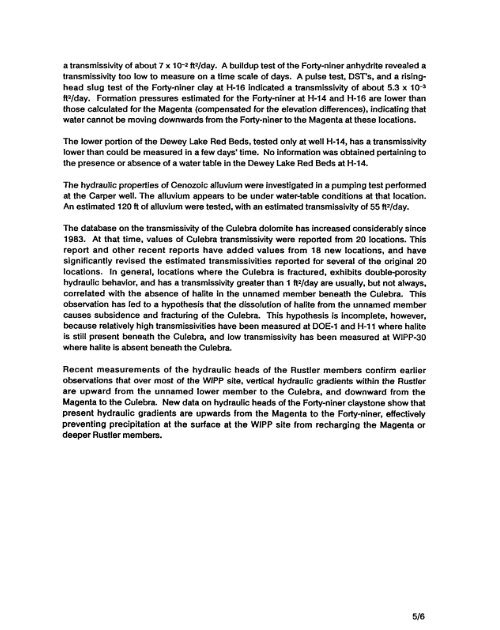Beauheim 1987 - Waste Isolation Pilot Plant - U.S. Department of ...
Beauheim 1987 - Waste Isolation Pilot Plant - U.S. Department of ...
Beauheim 1987 - Waste Isolation Pilot Plant - U.S. Department of ...
Create successful ePaper yourself
Turn your PDF publications into a flip-book with our unique Google optimized e-Paper software.
a transmissivity <strong>of</strong> about 7 x 10-2 ftZ/day. A buildup test <strong>of</strong> the Forty-niner anhydrite revealed a<br />
transmissivity too low to measure on a time scale <strong>of</strong> days. A pulse test, DST’s, and a risinghead<br />
slug test <strong>of</strong> the Forty-niner clay at H-16 indicated a transmissivity <strong>of</strong> about 5.3 x 10-3<br />
ftzlday. Formation pressures estimated for the Forty-niner at H-14 and H-16 are lower than<br />
those calculated for the Magenta (compensated for the elevation differences), indicating that<br />
water cannot be moving downwards from the Forty-niner to the Magenta at these locations.<br />
The lower portion <strong>of</strong> the Dewey Lake Red Beds, tested only at well H-14, has a transmissivity<br />
lower than could be measured in a few days’ time. No information was obtained pertaining to<br />
the presence or absence <strong>of</strong> a water table in the Dewey Lake Red Beds at H-14.<br />
The hydraulic properties <strong>of</strong> Cenozoic alluvium were investigated in a pumping test performed<br />
at the Carper well. The alluvium appears to be under water-table conditions at that location.<br />
An estimated 120 ft <strong>of</strong> alluvium were tested, with an estimated transmissivity <strong>of</strong> 55 ftz/day.<br />
The database on the transmissivity <strong>of</strong> the Culebra dolomite has increased considerably since<br />
1983. At that time, values <strong>of</strong> Culebra transmissivity were reported from 20 locations. This<br />
report and other recent reports have added values from 18 new locations, and have<br />
significantly revised the estimated transmissivities reported for several <strong>of</strong> the original 20<br />
locations. In general, locations where the Culebra is fractured, exhibits double-porosity<br />
hydraulic behavior, and has a transmissivity greater than 1 ft*/day are usually, but not always,<br />
correlated with the absence <strong>of</strong> halite in the unnamed member beneath the Culebra. This<br />
observation has led to a hypothesis that the dissolution <strong>of</strong> halite from the unnamed member<br />
causes subsidence and fracturing <strong>of</strong> the Culebra. This hypothesis is incomplete, however,<br />
because relatively high transmissivities have been measured at DOE-1 and H-I 1 where halite<br />
is still present beneath the Culebra, and low transmissivity has been measured at WIPP-30<br />
where halite is absent beneath the Culebra.<br />
Recent measurements <strong>of</strong> the hydraulic heads <strong>of</strong> the Rustler members confirm earlier<br />
observations that over most <strong>of</strong> the WlPP site, vertical hydraulic gradients within the Rustler<br />
are upward from the unnamed lower member to the Culebra, and downward from the<br />
Magenta to the Culebra. New data on hydraulic heads <strong>of</strong> the Forty-niner claystone show that<br />
present hydraulic gradients are upwards from the Magenta to the Forty-niner, effectively<br />
preventing precipitation at the surface at the WlPP site from recharging the Magenta or<br />
deeper Rustler members.

















